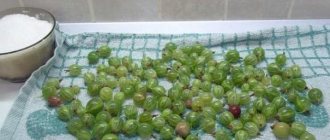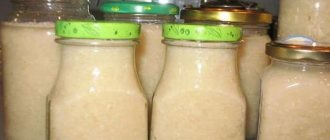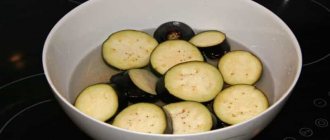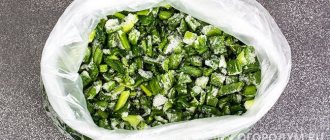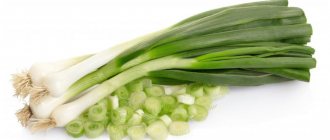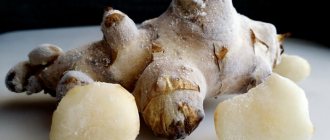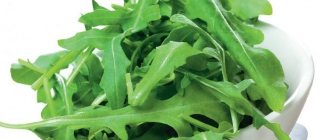To enjoy the taste of aromatic berries in winter, you can not only preserve them in the traditional way, but also freeze them. This storage method is becoming increasingly popular due to its simplicity and accessibility. Plums are not just tasty, but also very healthy berries. These fruits contain extremely useful dietary fiber, as well as acids, minerals, vitamins A, B, and E necessary for the human body. It reduces cholesterol levels in the blood and also helps eliminate heavy metals from the body. Helps normalize intestinal function and also strengthens the walls of blood vessels.
Canning is a rather labor-intensive process. Freezing is easier and more convenient. There are several ways to properly freeze plums while preserving all the beneficial properties. How to do this correctly to get maximum benefit?
Features of freezing plums for the winter
A properly frozen plum perfectly preserves not only its aroma and appetizing appearance, but also all the beneficial substances contained in the fruit.
To freeze it correctly, you must adhere to several basic rules:
- You can freeze plums with or without pits, as well as in sugar, syrup or in vacuum packaging. In this way, you can preserve not only fresh fruits, but also prunes.
- It should be frozen in small portions to make it convenient to use.
- During pre-freezing, the fruits should be in a container or on a plate in one layer to avoid damage.
It is also recommended to remove the bags on the second day to completely remove any air from them, and then place them back in the freezer.
Preparing the product for freezing
Freezing plums, like prunes, is a simple matter. But it is very important to prepare the berries correctly. Only whole fruits should be selected; cracked or spoiled ones should be removed. You need to wash them thoroughly and then dry them. For freezing fruits, plastic bags with or without a slider (special fastener), as well as various food-grade plastic containers, are suitable.
Preparing the Freezer
The freezer compartment of the refrigerator where the berries will be stored should first be thoroughly washed and dried. Enough space should be left in it so that the fruit can be placed in one layer for the first few hours for initial freezing.
It is worth considering exactly where the product will be stored. There should be no foods with a strong smell, such as meat, fish or seafood, in the refrigerator near the drains.
See also
How to freeze fresh squash for the winter at home and how to Read
Selection of fruits and preparation for freezing
To partially preserve their shape, choose plums that are dense, always ripe, but not overripe. Fruits that are even partially rotten, spoiled by pests, or cracked or deformed in other ways are not suitable. Do not prepare green plums either: they will be tasteless.
Fruits that are too soft and juicy are also frozen, but not in pieces, but in the form of puree and sweet syrup.
All berries must be thoroughly washed and dried before freezing. Wipe the fruit with a napkin to speed up drying.
How to freeze plums at home
Various recipes for preserving goodies for the winter can be found freely available on the Internet. Next we will talk about the most well-known methods.
With a bone
This is the least expensive method since there is no need to peel the berries. Washed and dried whole fresh plums should be laid out on a tray so that the berries hardly touch, then put in the freezer for several hours. This is done so that they do not become deformed when frozen.
After 3-4 hours, the plums are taken out and transferred to prepared containers or bags and returned to the freezer.
Seedless
If you are going to freeze seedless fruits, first wash them, dry them with a towel, and then remove the pit. The berries should be fresh and firm.
In this case, it is better to give preference to those varieties in which it is easily removed - the preparation process will go better and faster.
The fruit halves should be laid out in one layer on a plate, covered with cling film and placed in the freezer. They should sit in the freezer for 3-4 hours. The drains should be placed at a short distance from each other so that they do not touch.
Then the hardened fruits must be placed in bags or containers for freezing and sent to the freezer for long-term storage. It is preferable to freeze the fruits of the Hungarian variety.
Slices
You can also freeze it in slices. In this case, the fruits are also washed, dried, the pit is removed, and the pulp is cut into slices with a sharp knife so as not to cause damage. Next, the process is the same as for freezing pitted plums.
In sugar
There is also a way to freeze these berries in sugar. For such storage, you should wash the selected berries, let them dry or blot them with a towel to remove excess moisture.
A small number of slices or halves are placed in a container for freezing, and a small amount of sugar is added.
This is done until the container is completely loaded. For 1 kg of fruit you will need 200 grams of sugar or powdered sugar.
If you intend to store plums in the future in bags rather than in containers, then you should do this:
- place the prepared fruits on a dish or tray so that they do not touch;
- cover the berries with sugar or powder;
- freeze the berries in the freezer for 3-4 hours;
- after this time, transfer the frozen plums to the prepared dishes and return to the freezer;
- Remove the frozen berries from the freezer, put them in bags and return them to the chamber for further storage.
See also
The best recipes for how to properly freeze sorrel for the winter for soupRead
In syrup
For this freezing option, not only selected, but also slightly overripe berries are suitable. First the syrup is made. To prepare it, you need to take 800 grams of sugar for every liter of water. If the berries are very sweet, then you can add one teaspoon of lemon juice to this amount of water and sugar. If the berries are not too sweet, then you can do without it. Bring the water and sugar to a boil, stirring lightly until the sugar is completely dissolved.
The syrup should then be cooled. When it has cooled completely, you need to pour it over the prepared plums, placed in suitable containers, and put them in the freezer for storage.
It should be remembered that the plums do not need to be packed too tightly and the containers should not be filled to the very top, because the liquid will increase in volume when frozen. Properly frozen fruits will delight the whole family in the future.
In a vacuum
Dense and fleshy fruits are suitable for freezing, but in some methods even overripe berries can be used. In vacuum packaging, plums are also perfectly stored at low temperatures. To freeze fruits in this way, you need a special device - a vacuumizer. Plums are frozen and stored in special bags.
Slicing
Chopped plums save space in the freezing chamber. After thawing, they will not need further processing: just add them to salads, cook compotes, make smoothies.
Recipe:
- Plums with dense pulp are easy to cut into cubes, slices, circles and even grate.
- The pieces should be frozen before placing them in a common container, but if you package them in small portions for one-time use, then this procedure is not necessary.
- Remember to remove air from the packaging and pack everything tightly.
Frozen food storage
Frozen plums can be stored at a temperature of –10 for up to six months. If the temperature is lower (within -19 degrees), the shelf life will be longer - up to 9 months.
You can place a piece of paper in a bag or container with frozen plums on which the freezing date is written. This will help determine in the future which fruits should be used first.
How to make shortbread pie with plum filling:
To prepare the dough, use the following ingredients:
- sugar - 200 grams
- baking powder – 10 grams
- flour - 130 grams
- egg - 3 pcs.
- defrosted plums - 400 grams
Cut the defrosted plums into slices, knead with the prepared dough, and place in the mold. Preheat the oven to 180 degrees. Bake the pie for 20 minutes.
You need to think carefully in advance about what you can prepare from frozen fruits in winter. If you like to spend long evenings in winter near the TV or computer, with a cup of tea and homemade pie, then you can package 0.5–0.8 kilograms of mirabelle in bags, and for compote or puree, then smaller portions.
It must be remembered that in order for the fruits to be stored in their natural form, the temperature in the freezer should not be higher than -18 degrees.
Rules for defrosting plums
The frozen delicacy can be used in the preparation of various fillings in confectionery products, in the preparation of drinks, baby food, and also in its pure form.
To preserve all the beneficial properties, as well as appearance, you should defrost, following some recommendations:
- This must be done exclusively in a natural way. You cannot defrost berries in warm water or in the microwave; in this case, the berries will be hopelessly spoiled;
- After defrosting, a small amount of liquid will appear in the container. It can be poured into a separate container and then used;
- If the plums have been thawed, they should be used. There is no need to freeze them a second time.
Often, when preparing confectionery, housewives use plums without defrosting them completely. Frozen plums will be a real treat during the cold season.
Beneficial properties of fruits
Plums contain the following valuable nutrients:
- Apple acid;
- potassium;
- copper;
- manganese;
- iodine;
- vitamins.
The peel contains anthocyanins that affect free radicals, and quercetin will remove “bad” cholesterol from the body.
Delicious fruits have the following properties:
- strengthen the vascular wall;
- stabilize blood pressure;
- improve the functioning of the gastrointestinal tract;
- remove toxins from the body.
To avoid harm to health, fruits should not be consumed by people suffering from the following pathologies:
- diabetes mellitus;
- peptic ulcer of the stomach and duodenum;
- CRF.
Housewives keep the harvest fresh for many months. They carefully remove the plums from the tree, without damaging the wax coating, and place them in a glass container, sprinkled with cherry or currant leaves. The jars are stored in the cellar. Sometimes the fruits are dried, canned or frozen. The best option is to keep the harvest in the freezer, since in this case all vitamins and minerals are completely preserved.
Before planting the fruits, they should be sorted and ripe specimens selected. The Hungarian variety keeps well. Plum has good taste, it is juicy, fleshy, and does not lose its characteristics at low temperatures. Rotten or overripe specimens should not be used for freezing.
When canning, fruits lose 50% of their nutrients. Frozen plums are ideal for making compotes, delicious juice or plum jam.
The following varieties retain their presentation after freezing:
- El Dorado;
- Imperial Epinesis;
- Haganta;
- Empress.
To store fruits in the freezer, it is necessary to select high-quality fruits, which in winter are used to prepare compotes. Sometimes clean berries are placed in the refrigerator after removing the pit.
Housewives store the harvested crops using the following methods:
- sprinkle the plums with granulated sugar;
- the fruits are immersed in sugar syrup;
- contain fruits in vacuum packaging.
A properly prepared harvest does not lose its taste and nutrients throughout the entire freezing period.
Frozen plums are ideal for making compotes, delicious juice or plum jam.
Benefits for the body
Plums contain the main components necessary for the healthy functioning of the human body.
The unique composition of these fruits makes them beneficial for the digestive and nervous system, they protect against cancer, osteoporosis and hypertension. Recent studies have shown that tree bark is also beneficial for humans - its extract treats prostate diseases. Back in the 19th century, people knew about the many beneficial properties of these fruits. Plums were even credited with pain-relieving abilities. And although the ability to relieve pain has not found scientific confirmation, scientists have proven many other equally amazing abilities of this fruit. So what are the other benefits of these blue-violet fruits? Who are they useful for and what diseases can they protect against?
Strengthens bone tissue
According to a group of American scientists from Florida, plums, especially dried plums, are definitely useful for strengthening bone tissue. During observations, it was proven that plum lovers are less likely to suffer from fractures and are less susceptible to developing osteoporosis.
Improve digestion
If you want to improve digestion, eat plums! Rich in fiber, they have a beneficial effect on intestinal motility: they prevent constipation, thereby reducing the risk of colon cancer. Dietary fiber is essential for maintaining a feeling of fullness for a long time. In addition, it has long been proven that fiber (or rather, its special type - pectin) prevents high cholesterol and promotes weight loss. In addition, dietary fiber has a beneficial effect on the intestinal microflora, promoting the growth of beneficial bacteria and preventing the proliferation of pathogenic microorganisms.
Good for the cardiovascular system
Plums are a good source of copper, which in certain doses strengthens the heart and blood vessels and prevents many cardiac diseases.
Although it is worth remembering that in excess copper can be very dangerous for the body (however, by eating plums, it is almost impossible to get excess copper). But let's return to the benefits for the cardiovascular system. As already mentioned, these fruits are rich in fiber, which protects against the accumulation of high doses of cholesterol in the body. And this is good news for the blood vessels and heart, as it facilitates the functioning of the system. Another useful component of plums is polyphenolic compounds that have an anti-inflammatory effect, as well as the ability to lower blood pressure and strengthen the walls of blood vessels.
